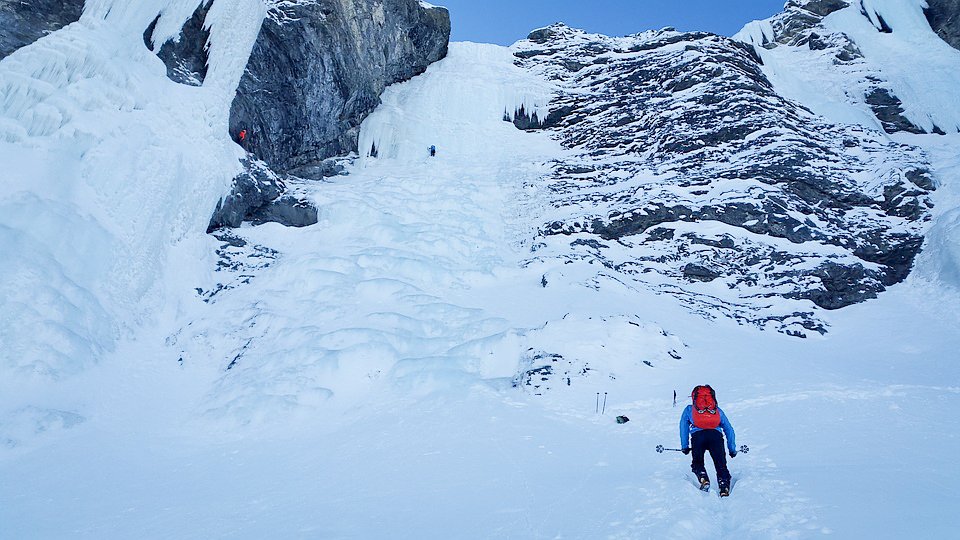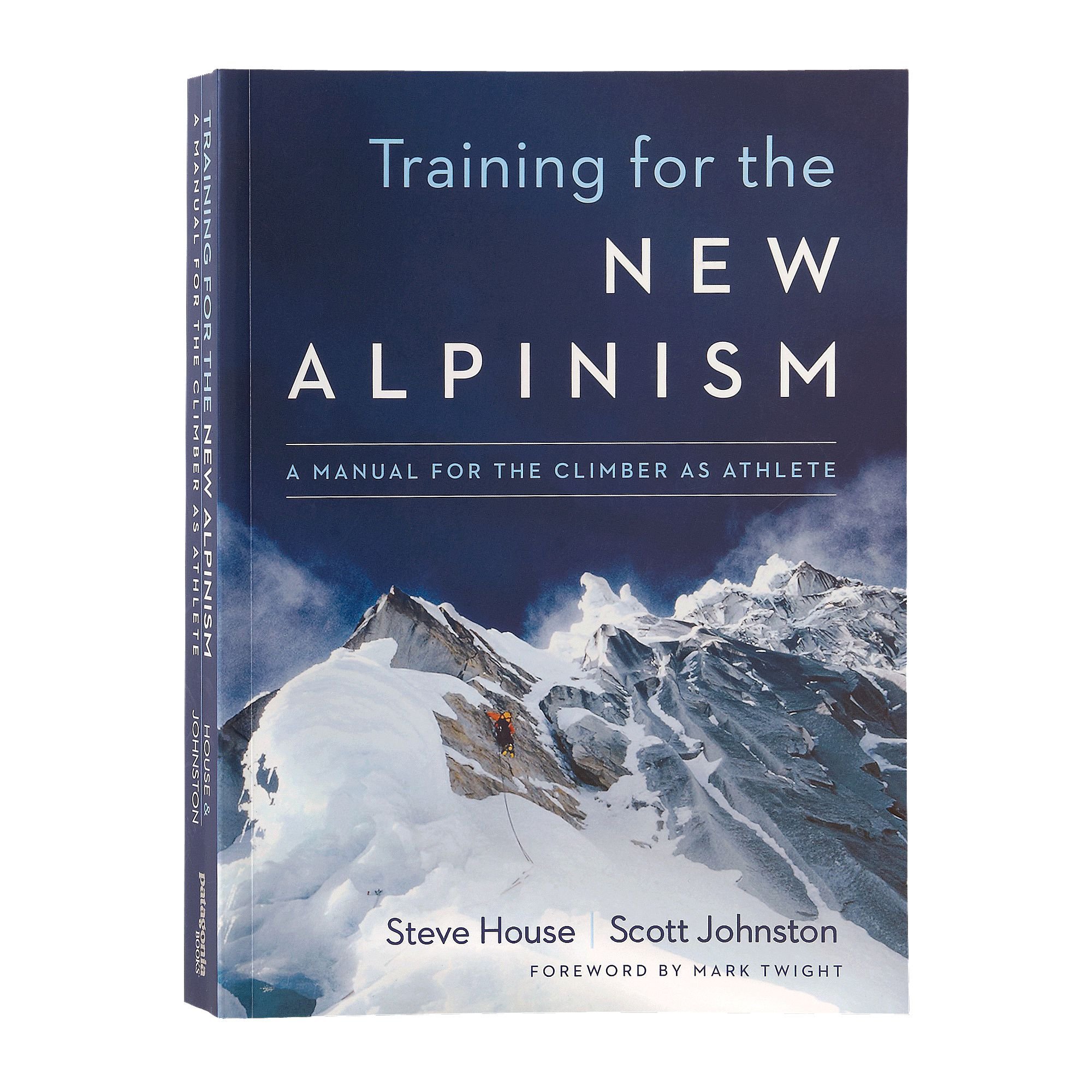Training For Ice Climbing and Drytooling:
Endurance
This post is part of a series on Training For Ice Climbing and Drytooling. Click below for sequential posts:
Build a Solid Foundation
Fortification
Basic Core
Hard Core
Endurance
Special Techniques
Head Games
Taking It Outside
NOTE: These workouts are intended for the fitness-minded climber. It’s up to you to manage your time and expectations. You may not initially be able to achieve the workout as described. Just working towards that goal will do wonders to get you ready for ice season.
After a 3 hour approach in knee deep snow, will you have enough juice to top out, descend, and make it home?
You’ve been doing:
Foundation with Fortification
Hard Core for two weeks
When standing below the 180’ P1 of a WI5+, you’ll quickly realize it’s a long, long way to the next belay. Now do that for for 4-5 pitches, do that everyday for two weeks. and then you'll be able to rock some of the bigger routes in the Canadian rockies. Let’s make sure you have enough juice to get up them.
By now you’re probably feeling pretty strong and climbing pretty darn hard. But what use is all that power if you can’t last?
No matter how much power you have, if you don't have muscular endurance you can injure yourself with too much repetition. Cardiovascular endurance makes it easier to climb longer and with more intensity, but also make other parts of the day, such as the approach and descent, easier. Besides helping you avoid heart problems and improve your circulation, endurance training burns more calories than weight lifting, so it can also help you maintain your weight. At the very least, the CDC recommends a minimum of 150 minutes (just 22 mins / day) of moderate cardio per week, or 300 minutes for maximum benefits.
Endurance Workout 3x / Week
Since the beginning of these posts, our goal has been to increase maximum strength, which is why we introduced strength training before endurance training. However, now we’re focusing on endurance, specifically, intensity and duration.
IMPORTANT: It is not a good idea to strength train after an endurance workout. Attempting a strength building workout when your muscles are already fatigued means you can’t work out at the intensity necessary to provide an ideal training stimulus. Working already fatigued muscles increases the risk of injury. If your muscles are already tired, coordination suffers and stabilizing muscles will be weakened. After a strength training session your body needs time to recovery to repair and rebuild muscle tissue.
In general, you should not do two different types of workouts back-to-back (like in the same session). You will achieve better results in both your strength and endurance training if you give your body sufficient time to recover (about a day).
Before getting into our Endurance Workouts, we need to talk about the Exertion Scale. Since we’ll be using it to describe the workouts, this fun chart explains it:
The three main exercises for building endurance are swimming, biking, and running. If you’re a triathlete, you already know these all too well.
You could also:
Hike (ideally something very long and steep)
XC Ski
Row
Dance
Do other sports like tennis, basketball, soccer, or racquetball
Or just use the cardio equipment a the gym: spinning machine, elliptical, treadmill
Whichever activity you choose, make sure to get you heart rate up and keep it up anywhere from 40 min-2 hrs. Here are some examples:
Swimming
Swim a mile, or work up to swimming a mile. No breaks. Exertion: 3-4 and finishing up with a 5-6. This will work out to 40 min for most people.
There are many reasons why swimming is one of the greatest all around exercises, but it’s the low-impact resistance training coupled with aerobic benefits that are of particular interests to ice climbers. Also there’s research that swimmers tend to have healthier lungs allowing them to process oxygen more proficiently, a quality that is clearly beneficial to ice climbers pushing their limits on hard climbs and/or at altitude.
Biking
1-2hr Bike Rides. Exertion: 4-5
Get on that bike and roll out. Could be road, mountain, gravel, BMX, whatever, so long as you’re able to consistently keep the exertion and your heart rate up. Riding up long hills are best as they require you to push harder for longer, just like on that next long overhanging section, or the approach to Grand Illusion in Smuggs, VT.
Running
Run for 40-60mins. Starting with level 3-4 exertion and finish with level 5-6.
Think hills, or trail runs. Road runs will do, but you’ll get more out it if you’re not able to relax into an easy, level pace. Remember to stretch your calves before/after.
Climbing
40-60mins of Climbing. This is not a time for projecting a route. Think laps. Do 3x 20 min pushes of continuous climbing. Climb at level 3-4.
If you just can’t get enough climbing, you can in fact build endurance for climbing by climbing, but only by climbing a lot. The key is to go for BIG mileage on easy terrain. This is not about power, it’s about mileage. You can double your effectiveness by downclimbing. However you do it, make sure to keep your heart rate up, NO RESTS. If you choose climbing as your endurance training, keep the exertion low to avoid tendon injuries: Level 3-4. Remember to do push-ups to work the counter muscles.
Rest
All the training in the world is useless if you don't rest. Resting makes the training stick. Below is one approach to maximizing workout effectiveness by slowing down.
-Schedule Down Time. By ‘down time’, we mean light duty activity: a short, fun, easy bike ride, an easy day of climbing, go for a walk. Don’t stop moving. Remember, and object in motion will stay in motion, but an object at rest will stay at rest.
Make sure you schedule at least 24 - 72hrs of rest between intense workouts. Your body needs time to heal, but more importantly, you’re risking injury if you don’t allow your body to recover.
SLEEP
Make sure you get sufficient sleep. Hormones released while sleeping are meant to induce a state of recovery in the body. Muscle-building activity and hormone concentrations increase during sleep.
HYDRATION
Dehydration significantly reduces climbing and athletic performance potential, but also delays the recovery process. Exercise and the accompanying increase in metabolism both increase the body’s need for water and electrolytes. When exercising the minimum amount of fluid intake per day is 3.7L/day for males and 2.7L/day for females.
EAT
(NOTE: Extensive nutritional advice is outside the scope of these posts. If you’re really serious about training, we highly recommend consulting a nutritionist for athletes or holistic wellness advisor.)
When you’re recovering, it’s time to eat. Protein is key for rebuilding muscle tissue the components for various cells, tissues, enzymes, and hormones. The point is that you must eat while recovering from training. You can save the dieting epics for the mountain, but your training is supposed to be make you harder to kill.
MASSAGE
Massage from a therapist or self-massage with foam rollers, massage sticks, and even just a tennis ball can reduce muscle stiffness and promote circulation helping to reduce recovery time.
Gently roll a ball or massage stick over all major muscle groups until you find a sensitive spot. Apply gentle direct pressure until the pain dissipates. Roll over the muscle again and repeat if necessary. Even if you feel massage doesn’t speed up your recovery, it might make you feel better compared to not getting massaged in the first place.
Other resources:
Uphill Athlete
Uphill Athlete is a platform for openly sharing proven training knowledge for the sports of alpinism, mountaineering, rock and ice climbing, ski mountaineering, skimo racing, and mountain running. Run by Steve House, Scott Johnston (House’s coach), Matt Naney, and Maya Seckinger.
Training for the New Alpinism
Training theory translated into practice to allow you to coach yourself to any mountaineering goal.











